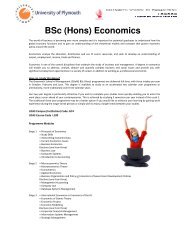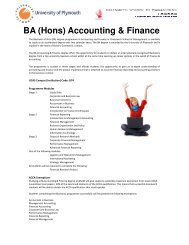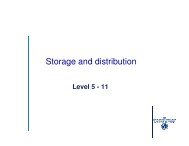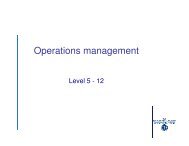(CIPS) Graduate Diploma - Greenwich School of Management
(CIPS) Graduate Diploma - Greenwich School of Management
(CIPS) Graduate Diploma - Greenwich School of Management
You also want an ePaper? Increase the reach of your titles
YUMPU automatically turns print PDFs into web optimized ePapers that Google loves.
the proactive identification and avoidance <strong>of</strong><br />
risk, as well as provision for post-event<br />
recovery initiatives.<br />
By the end <strong>of</strong> the unit students should be able<br />
to apply a variety <strong>of</strong> tools and techniques, in a<br />
diverse range <strong>of</strong> contexts, to proactively<br />
establish the level <strong>of</strong> risk presented and to<br />
recommend ways <strong>of</strong> avoiding, mitigating or<br />
managing those risks.<br />
IMPROVING SUPPLY PERFORMANCE<br />
(Integrative Unit)<br />
This unit is designed to consolidate the learning<br />
from the other two compulsory units in the<br />
<strong>CIPS</strong> Advanced <strong>Diploma</strong>. You will be assessed<br />
through either a case study exam or an<br />
assignment.<br />
Achieving success within the supply chain<br />
involves a complex range <strong>of</strong> variables, which<br />
can frequently be dependent on one another<br />
for the success <strong>of</strong> the supply chain.<br />
This unit is designed to enable students to use<br />
a range <strong>of</strong> techniques and strategies to develop<br />
and improve supplier performance in order to<br />
achieve competitiveness, efficiency and<br />
pr<strong>of</strong>itability within the supply chain.<br />
By the end <strong>of</strong> this unit, students will be able to<br />
measure and evaluate the effectiveness <strong>of</strong><br />
supply chain performance. They will be able to<br />
identify innovative development <strong>of</strong> systems to<br />
improve the performance <strong>of</strong> the supply chain,<br />
and make justifiable recommendations for<br />
implementation in order to aid the effectiveness<br />
<strong>of</strong> the supply chain.<br />
MARKETING FOR PURCHASERS<br />
(Optional Unit)<br />
This unit is designed to provide students with<br />
an appreciation <strong>of</strong> the marketing concept, the<br />
role <strong>of</strong> marketing within an organisation,<br />
marketing’s relationship with purchasing and<br />
supply, and marketing’s contribution to the<br />
overall strategic plan.<br />
Students will be<br />
introduced to<br />
marketing<br />
concepts,<br />
methods and<br />
techniques that<br />
are used to<br />
develop<br />
marketing plans<br />
with the ultimate<br />
aim <strong>of</strong> achieving<br />
customer<br />
satisfaction.<br />
These techniques may be applied to both notfor-pr<strong>of</strong>it<br />
and commercial organisations.<br />
By the end <strong>of</strong> the unit students should be able<br />
to evaluate and apply marketing tools and<br />
techniques, in a range <strong>of</strong> contexts, to achieve<br />
customer satisfaction.<br />
STORAGE AND DISTRIBUTION<br />
(Optional Unit)<br />
This unit is concerned with helping students to<br />
identify the major areas <strong>of</strong> concern in effectively<br />
managing stores and distribution throughout<br />
the supply chain. It is essential that goods are<br />
moved through supply chains to customers at<br />
the right time, in the right condition, at the right<br />
place and at the right cost. Failure in any <strong>of</strong><br />
these areas will add unnecessary costs to the<br />
ultimate customer while success will add value,<br />
and delight the customer.<br />
It is essential that storage, distribution and<br />
general logistics are coordinated, both<br />
upstream and downstream, in order to reduce<br />
lead times, provide agility and reduce<br />
unnecessary costs. In order for this to happen it<br />
is essential that relationships, both internally<br />
and externally, are honed to the appropriate<br />
level.<br />
To be effective, storage and distribution must fit<br />
in a seamless way to the total supply chain<br />
locally, nationally and globally.













